History of the Hall
Positioned at the junction of Foster Lane and Gresham Street, north east of St. Paul's Cathedral, the magnificent Hall, opened in 1835, is one of London's hidden treasures.
The Worshipful Company of Goldsmiths, more commonly known as the Goldsmiths' Company, is one of the Twelve Great Livery Companies of the City of London and received its first royal charter in 1327.
A ‘goldsmith’ has always been understood to mean a worker in both gold and silver, and today encompasses those who work in platinum and palladium as well. Gold and silver have always been essential for the coinage of the realm and much sought after for ornament and display of wealth. In the 1179-80 Pipe Roll entry (the earliest surviving reference to the city companies) a ‘gild of Goldsmiths of which Ralph Flael is alderman’ is referenced. The entry lists 18 guilds fined by King Henry II for operating without a licence. The Goldsmiths head the list of these guilds with a fine of 45 marks, or £30, far higher than any other – an indication that even at this time the guild must have been well established.
In 1300 King Edward I passed a statute requiring gold and silver to be of a defined standard and requiring ‘les Gardeins du Mester’ (Guardians of the Craft) to test it and mark it with the leopard’s head. This was supposedly taken from the royal arms and later known as the King’s mark. This is the first legal recognition of the Company, and the beginning of hallmarking in Britain.
In 1327 the Company received its first royal charter, giving it the right to enforce good authority, the standards within the trade and emphasising its standing over provincial goldsmiths. This marked the beginning of the Company’s formal existence as a craft guild, with St. Dunstan as its patron saint.
At this point the Goldsmiths decided they should have a headquarters. The chosen property lay near the ‘Goldsmithery’ or goldsmiths’ area, at the north end of Foster Lane in the parish of St. John Zachary. In 1339, 19 goldsmiths bought it for the use of the Goldsmiths' Company. Though extended in area, this is the identical site on which Goldsmiths’ Hall stands today. No other Company can claim a longer or earlier tenure.
In 1341, the Goldsmiths sought to extend their privileges in order to help those injured at work, as well as the poor. They obtained a licence to purchase and hold tenements and rents to the value of £20 for the relief of infirm members but this later proved to be legally inadequate, possibly because the Crown had resisted their full demands, fearing the amount of land that was likely to pass into perpetual tenure. The final wording was left deliberately vague so that it could later be called into question.
Further certainty would be given in a new charter from Richard II in February 1393, allowing the Company to own property and rents to the value of £20 yearly for specific charitable purposes.
In 1363, goldsmiths and silversmiths required to have a mark unique to them, to be struck on all their wares to identify the maker.

Earliest surviving copy of the Goldsmiths' Company Charter recorded in the Court Minute Books, 1349
During the medieval period, the whole Company met at least three times a year when the ordinances were read aloud and decisions by the Wardens ratified. Such questions as new leases, choice of almsmen, election of liverymen and trade disputes were dealt with on these occasions. Two renters were annually appointed to collect the rents and keep an eye on the condition of various properties. These were men of standing on the Livery but unlike other companies they were not Wardens. There were four Auditors, all past Wardens, also a Clerk and a Beadle. The Wardens were chosen at a common assembly in April and took office on 19th May, the feast of St. Dunstan, the Company’s patron saint. That day would begin with a solemn procession to church and end with a feast.
Further extension of the Company’s powers can be seen in 1462. Edward IV, after confirming the previous charters, granted that the Wardens and their successors be a body corporate having perpetual succession and a common seal and that as ‘the Wardens and Commonalty of the Mystery of Goldsmiths of the City of London’ they may implead and be impleaded in any court. They were to be able to make good and reasonable byelaws and ordinances for the regulation of the mystery, to retain their right of search and powers of publishing offenders in London and elsewhere.
This marks the high point in the history of the Goldsmiths' Company. Other charters followed but they mainly examined and restated the position achieved by the Goldsmiths in 1462.
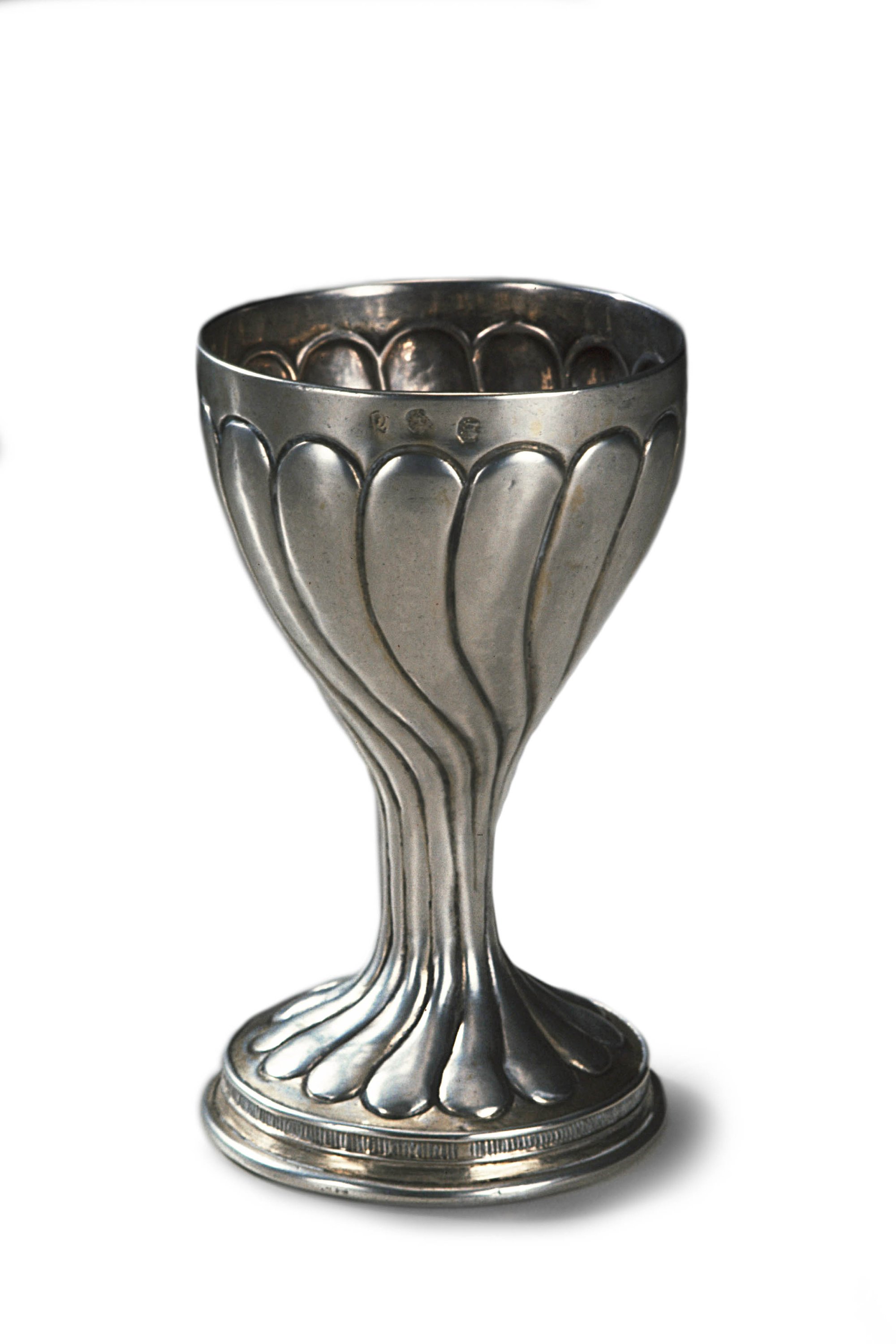
1493 Cup in the Company's Collection
In 1478 a statute of King Edward IV made the Goldsmiths' Company specifically responsible for wares found to be below standard, and for the penalties involved. As a result the Wardens reorganised the system of assaying and marking gold and silver, and the first assay office was established at Goldsmiths’ Hall, overseen by a full-time Common Assayer.
A date letter was introduced to the marking system and workers were required for the first time to bring their wares to Goldsmiths’ Hall to receive the ‘hallmark’.
Goldsmiths’ apprentices, who usually served their masters for a term of seven to ten years, were expected to have reached certain educational standards. In the 1490s it was ordained that the apprentice must be able to read a passage out loud to the Wardens and write in English and Latin in a book that was to ‘lie dormant’ in the Hall for the purpose. Occasionally the rule was relaxed, most often when the boy was an orphan, but the master was then bound to teach him to read and write and later had to produce evidence that he had done so.
The Company awarded its first university scholarships to Oxford and Cambridge on 26 April 1564. Since that time the Company has always used part of the charitable income for educational purposes. The minutes from the meeting note that the Wardens agreed that:
'this companie shall mayneteyne one scholar at one of ye universities with ye yearly allowance of viL.xiijs. iiijd (£6 13s 4d) for his exhibicion condicinally that ye ende of his studie shall tende to divinitie. And that ye same scholar shal be called ye first gold-smythes scholar’.
In 1571, the Goldsmiths' Company was granted the right of a helm, crest and supporters to the arms which it had ‘long tyme borne’. The original grant of arms was not known, if indeed there had ever been one, but from various references it is evident that they were in use from the 14th century. The leopard’s heads are an obvious allusion to the king’s mark of 1300, and the cups and buckles are meant to show that all categories of goldsmithing are represented in the Company; the cups for the large or plate workers, the buckles for the small workers or jewellers.

Coat of Arms
In 1588, The Goldsmiths’ Company were appointed as one of the Keepers of the Troy Weight, the measurement of weight used for gold and silver. The nest of standard weights has remained in the Hall ever since.
Written records of the Trial of the Pyx began in 1603. The trial, which had been carried out by goldsmiths since the 13th century, would later establish Goldsmiths’ Hall as the venue from the Trial in the 1870 Coinage Act.
The seventeenth century marks a period of financial disaster for the Goldsmiths as for the other city companies. The Crown had long looked to the City as an easy source of revenue, especially at times of national emergency. Now compulsory loans and gifts from the City became an important factor in the policy of the Stuart kings to rule without a parliament whenever possible.
The Irish Society was formed as a committee of the Corporation of the City of London and the sum of £52,000 was raised somewhat reluctantly by the companies after several Wardens had been imprisoned for default. The Goldsmiths, with the Armourers, the Cordwainers and the Painter Stainers, were given land to the south-east of Derry, which now became known as Londonderry because of its enforced association with the City of London. The Irish lands proved to be a constant source of trouble and a drain on the Company’s funds.
The second Hall was erected on the site of the original merchant’s house, incorporating ten shops. The Palladian red-bricked building was the work of Nicholas Stone, the King’s Mason, with advice from Inigo Jones, the King’s Surveyor.
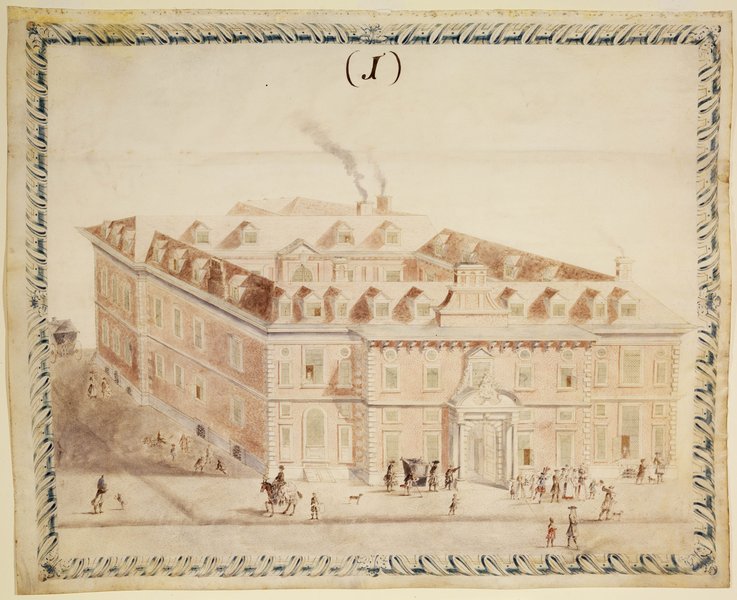
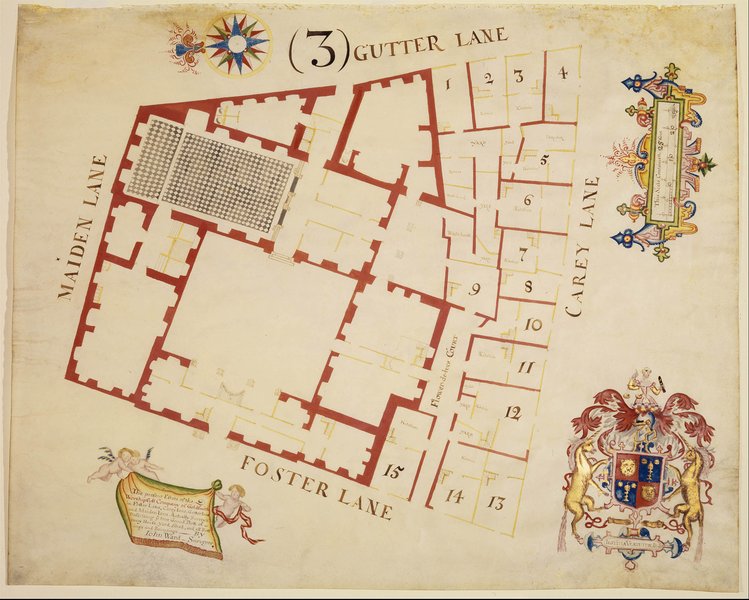



Many other demands for loans to the Crown or new taxes followed, including the imposition of ‘Ship Money’ at a time when the Company was striving to save to rebuild the Hall. A second Hall was erected on the site of the original merchant’s house, incorporating a further 10 shops, between 1634 and 36. The Palladian red-bricked building was the work of Nicholas Stone, the King’s Mason, with advice from Inigo Jones, the King’s Surveyor. The Company had to pay for a licence for rebuilding and, when the stone was delivered it was immediately ‘detained for the King’s use’ and a further quantity had to be purchased. The Company was forced to borrow heavily.
In 1637, 34 major items of plate were sold. The Company ensured that the weights and names of the donors were recorded so that, when they were financially able, they could have the pieces remade.
In 1640 the King demanded £50,000 from the City, £3,500 being the Goldsmiths’ share. The Company, already heavily in debt, were forced to borrow the money at a high rate of interest. Even greater demands followed; in June 1642 the City was asked for a loan of £100,000 a year, the Goldsmiths’ share to be £7,000, said to be for the relief of Ireland.
By August of 1642, with the advent of the English Civil War, Parliament had taken over the City Companies’ supplies of gunpowder and 6,000 muskets and 4,000 pikes were demanded to arm the troops under the Earl of Essex. The Goldsmiths’ Company made an inventory of those arms it could supply and agreed also to provide an ‘ingine to quench fire’, also ladders and fire buckets for the defence of the City. The Beadle complained that he was unable to collect quarterage as so many tenants ‘have shut up shop and gone for soldiers’. The garrets at the Hall were converted to store corn, a tremendous fire risk.
During these years, it seems incredible that the Goldsmiths’ Company managed to hold on to the remainder of its plate and indeed agreed to lend it at the time both to Sir John Wollaston and Sir Thomas Vyner when they both held office as Sheriff and Lord Mayor.
The new Hall from the 1630s was gutted by the Great Fire of 1666, leaving only the walls standing. The Company’s treasures and records were saved by Sir Charles Doe, an assistant, who commandeered a cart and took them to safety to a house in Edmonton. The restoration of the Hall was completed by Edward Jerman in 1669, although a further fire in the Assay Office destroyed the southwest corner of the new building in 1681.
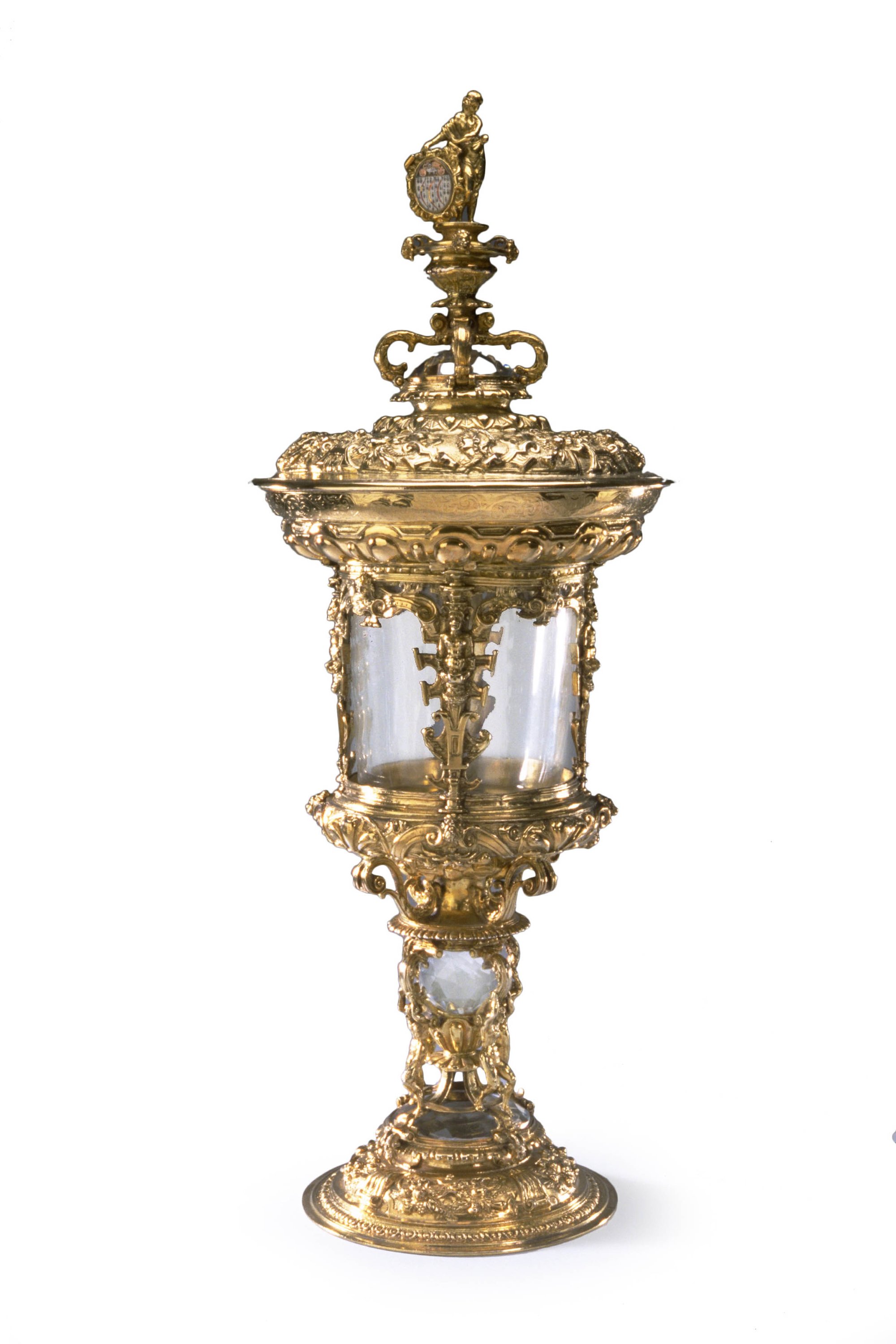
The Bowes Cup
After the Restoration of the monarchy in 1660, great efforts were made to replace the earlier plate losses.
Nine cups were remade by Arthur Manwaring, but as a result of the Great Fire of 1666 - which deprived the Company of the use of the Hall for three years and meant loss of rent from much City property, - seven of the new cups and all the old plate except for the Bowes Cup, Gibbon Salt and Rogers Salt were sold to Sir Robert Vyner to help pay off debts.
Several leading goldsmiths who had for some time past been keeping ‘running-cashes’ in order to be able to lend money to their customers at short notice, now all but abandoned the practice of making and selling plate in order to run full-time banking houses and the promissory notes they issued formed the style of our first bank notes. Prominent members of the Goldsmiths' Company such as Sir Robert Vyner, Sir Jeremiah Snow, Alderman Edward Backwell, Valentine Duncomb and Robert Blanchard made vast fortunes in their new businesses (and some subsequently lost them in 1672 by Charles II’s stop of the Exchequer), and were generous in their gifts to the Company.
London goldsmiths had long had to compete against foreign workmen, refugees from wars and religious persecution in their own country, and the Company had been vigilant in protecting its own members; but a major problem had to be faced at the end of the 17th century with the influx of Huguenots who fled from France after revocation of the Edict of Nantes in 1685. Large numbers of these refugees were now settling in London, either outside the City boundaries or within the Liberty of St. Martin-le-Grand, to which the City regulations did not apply.
The Huguenot goldsmiths first evaded the hallmarking laws by persuading a few London craftsmen who had their makers’ marks registered at the Hall, to present the French work for assaying and marking as if it were their own.
Further petitions from indignant members of the London trade followed. However, in 1725 the Attorney-General established unequivocally that the right of entering a maker’s mark at Goldsmiths’ Hall could not be denied to anyone, whether he was free of the Company or not. At this the London goldsmiths reluctantly had to back down and accept the Huguenot craftsmen. The Huguenots ultimately gave the trade a much needed boost, both in design and technical skill.
Meanwhile the Company continued to be heavily in debt and in May 1711, besides announcing various stringent economies, it was decided to sell off the bulk of the plate collection and buy tickets in the Government Classis Lottery. Twenty tickets were purchased, but it appears the Company received no prizes. The sale of the Irish Estates to the Earl of Shelburne was completed in 1729. The money received from this paid off the most pressing debts and the residue was carefully invested. The Company was becoming financially secure again, due mainly to the efforts of Charles Hosier, whose portrait still hangs in the Court Room.
Hosier also suggested that the plate that had been sold should be replaced, resulting in the marvellous range of pieces all dated 1740-41 and still in the Company’s possession, which were ordered from some of the leading goldsmiths of the day, Paul de Lamerie, Thomas Farren, Humphrey Payne and Richard Bailey. This plate is still displayed in the Livery Hall today. The total weight exceeded 2,300 ounces and replaced plate sold over the previous century to meet the Company’s financial requirements.

1741 Paul De Lamerie Dish & Ewer
With patriotic fervour, in 1798 the Court issued a list of economies to be practised in the running of the Company’s affairs and announced that the sum of £1,000 was to be given ‘in aid of the exigencies of the State, and that the same be continued annually during the war’. Many special subscriptions were raised for the relief of the widows, wives and orphans of the soldiers, sailors and marines killed or wounded in the various campaigns. In 1816 an extraordinary Trial of the Pyx was held at Goldsmiths’ Hall to test French gold money coined by the Mint ‘for the greater facility of paying the troops under His Grace the Duke of Wellington’, the British army of occupation in France. These coins later caused great trouble in France where they were seized as counterfeit. Louis XVIII, having given permission for the coining, failed to circulate this fact in his own country.

Watercolour of Goldsmiths' Hall
The Company had been proud that its wartime economies did not hinder its charitable activities, but the upkeep of the Hall had certainly suffered. In the early 19th century some parts of the building even had to be shored up with scaffolding.
In 1829 the existing Hall, which dated from the 17th century, was demolished, and construction began on a new structure. It was designed by Philip Hardwick, the Company’s surveyor, and was opened with a grand banquet in July 1835. The Hall still stands today, the third Goldsmiths’ Hall on this site since the purchase of the land in 1339.
In 1812, 20 almshouses were erected on the Perryn estate in Acton, west of London. This land had been left to the Company by John Perryn in 1657. In 1832, a new schoolhouse was built by the Company in Stockport. The schoolhouse was for the school founded by Edmund Shaa, a benefactor of the Company, in the 15th century.
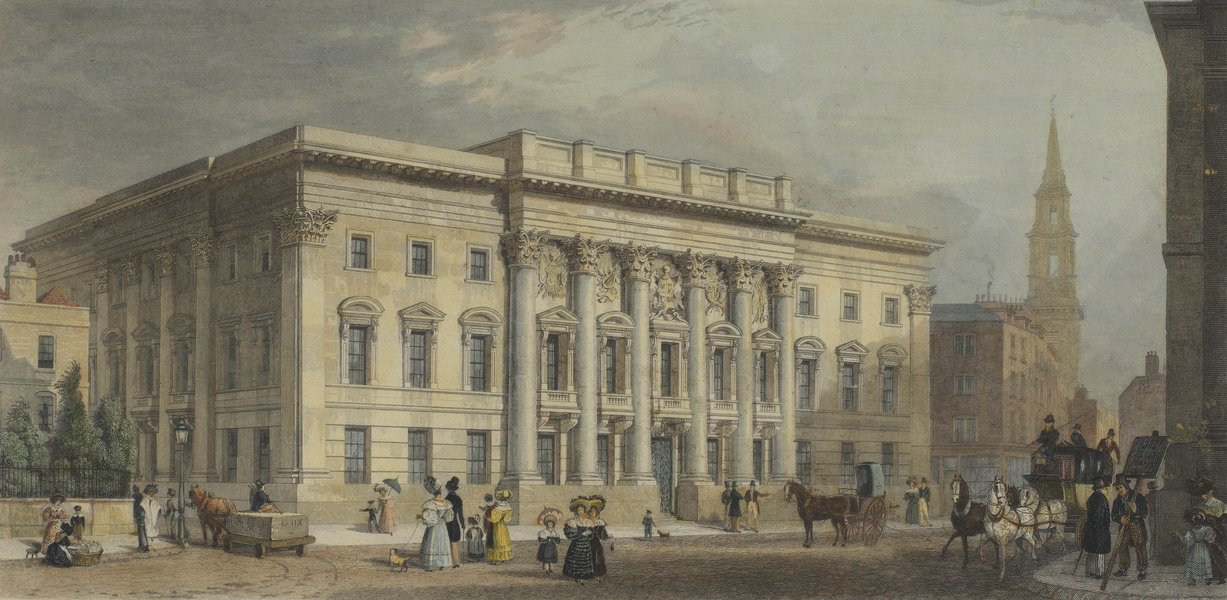
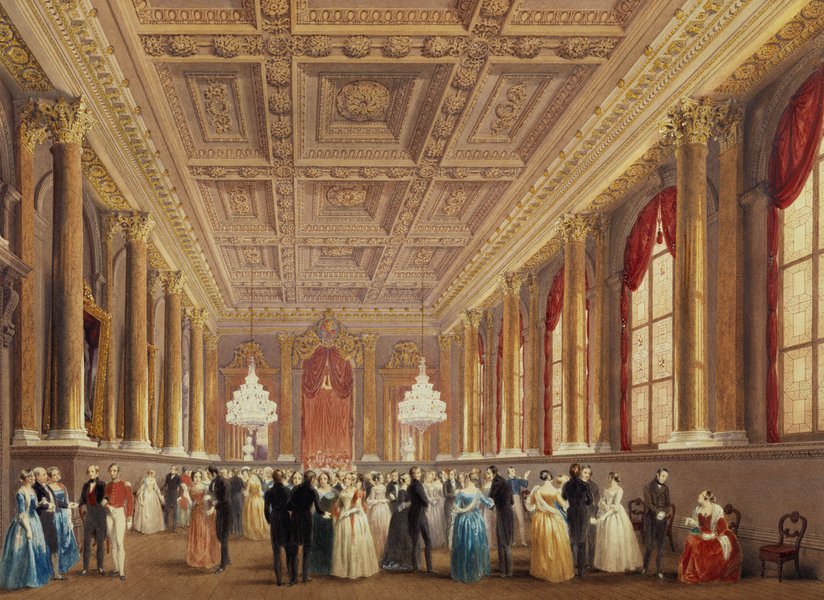

Although hallmarking had always kept the Company engaged with the craft, during the later 18th century trade membership fell. With it, so did engagement with the practical side of goldsmithing. This did not last for long.
The Prince Consort became an Honorary Liveryman in 1840 and it may well have been due to his enthusiasm that the Company decided to take a more prominent part in the Great Exhibition of 1851. The company awarded £1,000 in prizes ‘as a special encouragement to manufacturers of plate in this country’ and later purchased £5,000 worth of ornamental plate to commemorate the exhibition.
In 1871 the Company proposed a scheme for improving technical education in the trade, and established an annual competition which offered prizes for design and execution of works in precious metals. A master of drawing and modelling, who was teaching goldsmithing apprentices in Clerkenwell, was appointed to give regular free classes to students.
In 1877 the Goldsmiths’ decided to unite with other Livery Companies in a major endeavour for the advancement of technical education in general throughout the country. A provisional committee of representatives from the City Corporation and the Livery Companies was formed and as a result of their recommendations, the City and Guilds of London Institute was founded in 1878. The Goldsmiths' Company has been a major benefactor to the Institute and its interest and involvement continues, and the City and Guilds of London Institute is today one of the main examining bodies for vocational qualifications.
Land and buildings at New Cross, in south east London, formerly used by the Royal Naval School, were purchased by the Goldsmiths’ Company in 1889 and opened in 1891 as the Technical and Recreative Institute ‘for the promotion of technical skill, knowledge, health and general well-being among young men and women of the industrial, working and artisan classes’. In 1904 the College was presented to London University and changed its name to Goldsmiths’ College. The Company still has two representatives on the college delegacy.
In 1903, the collection of economic literature which had been owned by Professor Foxwell was purchased by the Company and given to the University of London Library. In 1908, The Goldsmiths’, Silversmiths’ and Jewellers’ Art Council of London was established by George Booth Heming as an annual competition of craftsmen and schools in London. The Goldsmiths’ Company has been a prominent supporter along with the trade itself and the competition continues to this day under the title of The Goldsmiths’ Craft and Design Council.
In the same year, Readerships in metallurgy were endowed by the Company at Cambridge, and in English at Oxford.
Design competitions began in 1926 for Ascot trophies, marking a long and continuous involvement in modern design for silver wares through competitions, exhibitions and lectures.

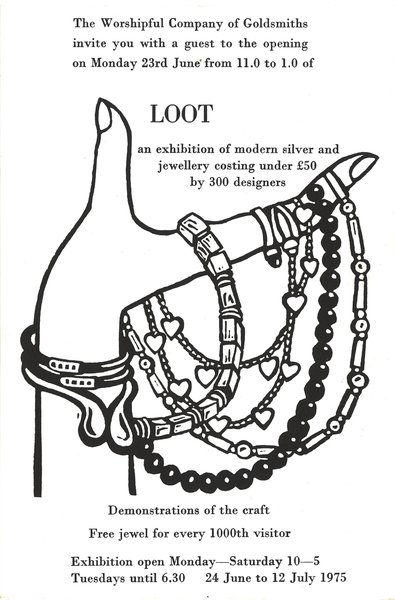
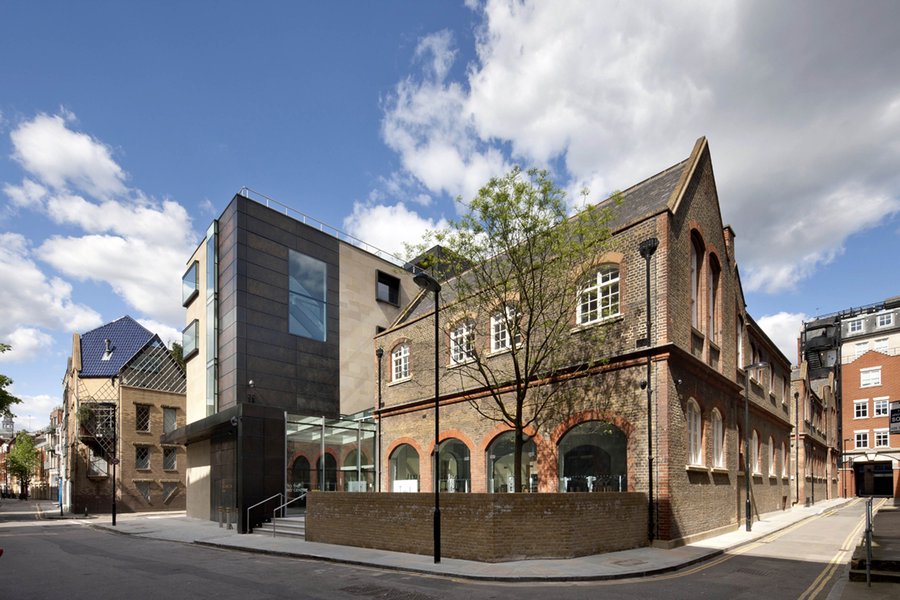
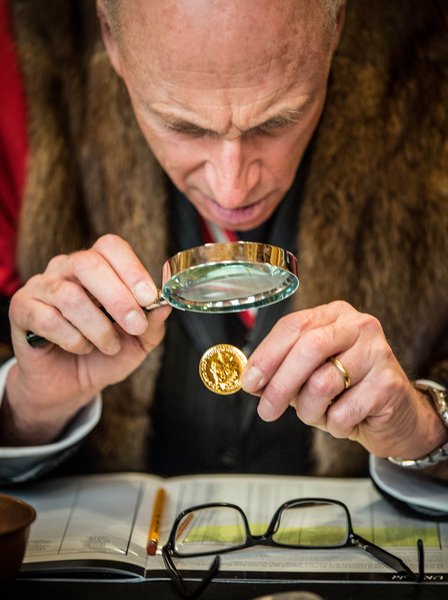
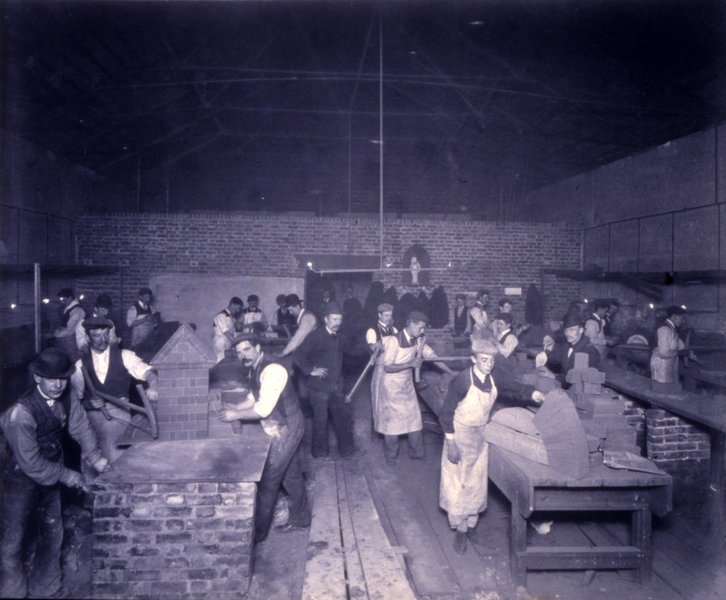
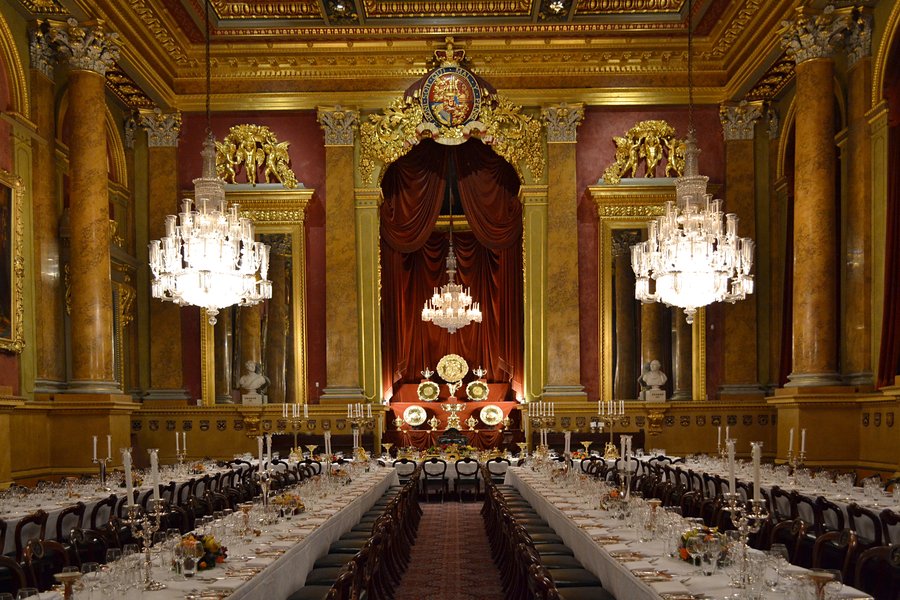
Life in the Company continued as best it could during the war until the night of 29th December 1940 when the Assay Office was burnt out. The Trial of the Pyx continued at the Hall, but the Assay Office’s salvaged punches and equipment were sent down to Reigate where the assaying service was soon re-established.
In April 1941, a direct hit destroyed the front south west corner of the Hall. However, the outer Portland stone facing was carefully collected and stored and replaced when that portion was restored after the war.
The damage inflicted on the trade by the war, and subsequent austerity, galvanised the Company to increase its support for silversmiths and jewellers. In 1946, a Design and Research Centre was established at the Hall with financial help from the Company and government grants. The Company was also involved in the 1951 Festival of Britain, and a series of major exhibitions of historic and contemporary silverwork were staged at the Hall during the decade.
A programme of design competitions and exhibitions which had begun in the inter-war years grew in size and ambition.
The landmark ‘International Exhibition of Modern Jewellery 1890-1961’ at Goldsmiths’ Hall was a turning point for resurgent artist jewellers released from the austere aftermath of the Second World War. The Company received sponsorship in 1961 from De Beers consolidated mines which formed the nucleus of a new collection of jewellery at the Hall.
Each year since then, the Company has purchased or commissioned contemporary designed jewellery in precious metals.
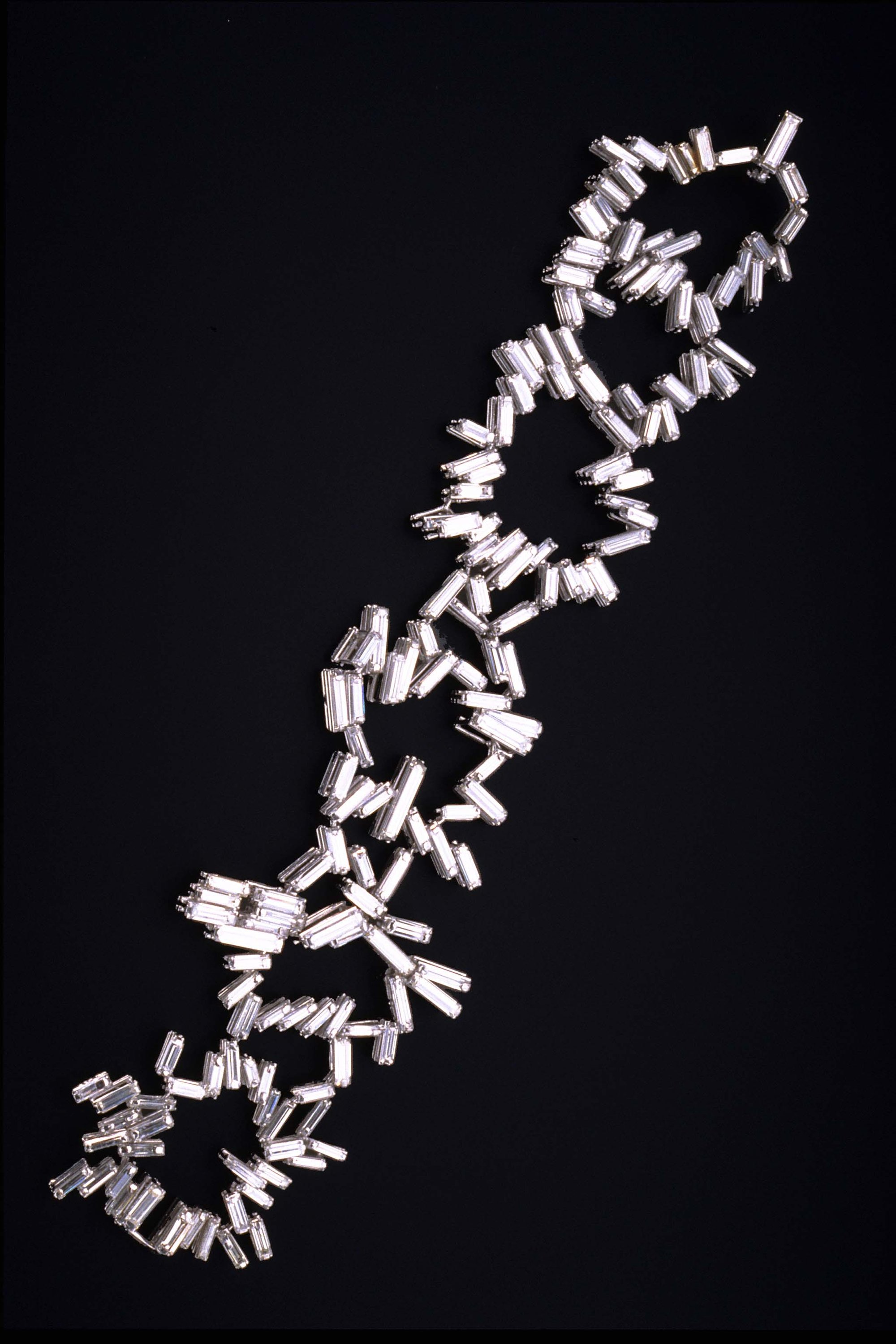
Bracelet, 1961, by Roger King. First Prize De Beers British Jewellery Competition
In 1976, the first ‘Loot’ was held at the Hall. 2,000 exhibits were chosen from 300 designers, and everything on view was also on sale for less than £50. This selling exhibition grew into the annual Goldsmiths' Fair, first held in 1982 and still a highlight of the Company’s year. Encouragement was also provided by buying new work from contemporary craftsmen to add to the Company’s Collections.
In 2012 the Company opened the Goldsmiths' Centre in Clerkenwell. The £17.5 million project, which includes workshops, training facilities and exhibition spaces, represents the largest direct investment in the trade made by the Company, and the product of a 700-year tradition.
Positioned at the junction of Foster Lane and Gresham Street, north east of St. Paul's Cathedral, the magnificent Hall, opened in 1835, is one of London's hidden treasures.
A history of hallmarking: the Goldsmiths' Company has been responsible since 1300 for testing the quality of gold and silver.
Our members are the lifeblood of the Company, made up of approximately 1550 freemen and 285 liverymen.